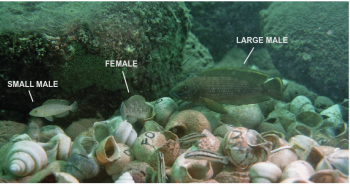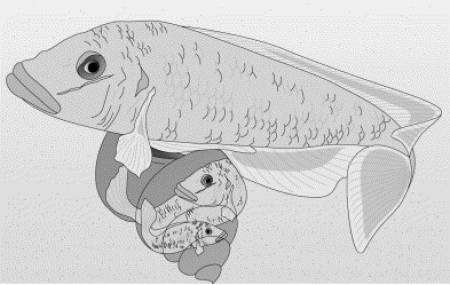Table of Contents
Group 5
Alternative reproductive tactics in cichlid fish
Wiki site of the practical exercise of the III Southern-Summer School on Mathematical Biology.
Here you will find the exercise assigment and the group's products.
If you are a group member login to edit this page, create new pages from it, and upload files.
Final Presentation
Group
- Chaquea, Jose Dario; Universidad de los Andes, Depart. Biomedical Engineering, Colombia
- Couto, Thiago Belisario D'Araújo; National Institute of Amazonian Research, Brazil
- Giese, Adriana Carolina; Centro Nacional Patagónico, Argentina
- Simões Yamaki, Tania Patricia; University of Campinas, Physics Institute, Brazil
- Tonhatti, Carlos Henrique; University of Campinas, Institute of Biology, Brazil
Assistants
- Bernardo Niebuhr
- Diogo Melo
- Fernando Rossine
Assignment
Alternative reproductive strategies within the same species is a widespread phenomenon in fish. In the cichlid fish Lamprologus callipterus, large males collect and guard shells in which females enter and release their eggs. There is strong sexual size dimorphism in this species and the male are too large to enter the shell. Females, on the other hand, remain primarily in the shell during the whole reproductive period. Since the males monopolize resources, this behavior is referred as the bourgeois tactic.
Only males large enough to carry shells are able to adopt this strategy. Alternatively, smaller males may attempt to release their sperm in a guarded shell, while the large male is away (parasitic tactic) 1). If the male is small enough, it may even enter the shell, go to its innermost part and remain there during the fertilization period 2).
The male size distribution of populations of this species is clearly bimodal, allowing the distinction of two separate groups of individuals: large (also called nest males) and small (dwarf males). Wirtz-Ocaňa and collaborators (2013) have shown that male size is paternally inherited in this species. Large male father large individuals and dwarf males father small individuals 3).
Parasitic dwarf male (smallest individual) is shown inside the shell with the female. Nest male is shown in the outside. From Taborsky (1998).
Questions
Different questions can be investigated by modeling this system. It is important to keep mind which are the relevant features on the problem being studied. A possibility is to think about a population model that explains in which conditions each reproductive strategy is more appropriate and in which conditions there is long-term coexistence of both strategies in a population.



